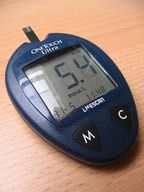11.57: Diabetes
- Page ID
- 14402

What do these foods have in common?
These foods are all high in sugar. A person with diabetes has to avoid these types of foods.
Diabetes
Diabetes is a non-infectious disease in which the body is unable to control the amount of sugar in the blood. People with diabetes have high blood sugar, either because their bodies do not produce enough insulin, or because their cells do not respond to insulin. Insulin is a hormone that helps cells take up sugar from the blood. Without enough insulin, the blood contains too much sugar. This can damage blood vessels and other cells throughout the body. The kidneys work hard to filter out and remove some of the extra sugar. This leads to frequent urination and excessive thirst.
There are two main types of diabetes, type 1 diabetes and type 2 diabetes. Type 1 diabetes makes up about 5-10% of all cases of diabetes in the United States. Type 2 diabetes accounts for most of the other cases. Both types of diabetes are more likely in people that have certain genes. Having a family member with diabetes increases the risk of developing the disease.
Either type of diabetes can increase the chances of having other health problems. For example, people with diabetes are more likely to develop heart disease and kidney disease. Type 1 and type 2 diabetes are similar in these ways. However, the two types of diabetes have different causes.
Type 1 Diabetes
Type 1 diabetes occurs when the immune system attacks normal cells of the pancreas. Since the cells in the pancreas are damaged, the pancreas cannot make insulin. Type 1 diabetes usually develops in childhood or adolescence.
People with type 1 diabetes must frequently check the sugar in their blood. They use a meter to monitor their blood sugar (Figure below). Whenever their blood sugar starts to get too high, they need a shot of insulin. The insulin brings their blood sugar back to normal. There is no cure for type 1 diabetes. Therefore, insulin shots must be taken for life. Most people with this type of diabetes learn how to give themselves insulin shots.

Type 2 Diabetes
Type 2 diabetes occurs when body cells are no longer sensitive to insulin. The pancreas may still make insulin, but the cells of the body cannot use it efficiently. Being overweight and having high blood pressure increase the chances of developing type 2 diabetes. Type 2 diabetes usually develops in adulthood, but it is becoming more common in teens and children. This is because more young people are overweight, due to a high sugar and fat diet, now than ever before.
Some cases of type 2 diabetes can be cured with weight loss. However, most people with the disease need to take medicine to control their blood sugar. Regular exercise and balanced eating also help, and should be a regular part of the treatment for these people. Like people with type 1 diabetes, people with type 2 diabetes must frequently check their blood sugar.
Symptoms
Common symptoms of diabetes include the following:
Complications
Complications of diabetes can include the following:
- eye complications
- foot complications
- skin complications
- high blood pressure
- hearing issues
- nerve damage
- kidney disease
- artery disease
- stroke
- stress
Summary
- In type 1 diabetes, the pancreas cannot make enough insulin, the hormone that helps take up sugar from the blood.
- In type 2 diabetes, the body cells cannot use insulin properly.
Explore More
Use the resource below to answer the questions that follow.
- Diabetes and the Body at http://www.youtube.com/watch?v=jHRfDTqPzj4 (8:42)
- How does a "normal" body respond when it senses that glucose levels in the blood stream are increasing?
- How does insulin affect blood glucose levels? What mechanism does it act by?
- What causes type 1 diabetes? How does this affect the body?
- What causes type 2 diabetes? What are three symptoms of type 2 diabetes?
- How can the liver make the situation worse with type 2 diabetes? Why does the liver respond this way?
- Which type of diabetes is most likely to be influenced by dietary changes?
Review
- What is diabetes?
- Compare and contrast type 1 and type 2 diabetes.
- What can increase your risk of developing type 2 diabetes?
- List three common symptoms of diabetes.

